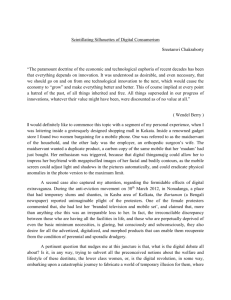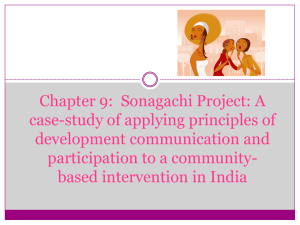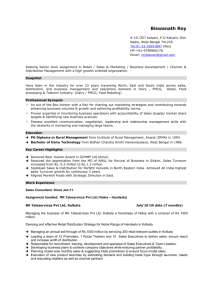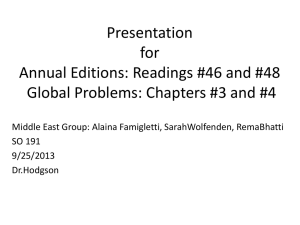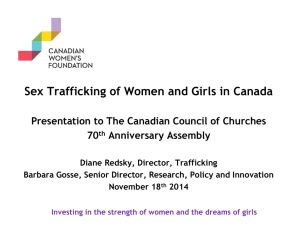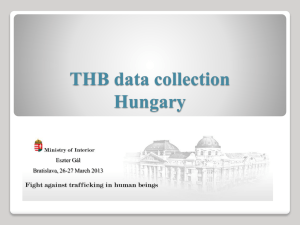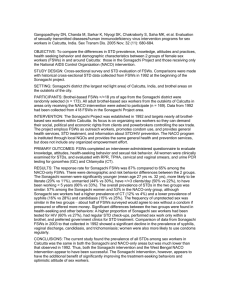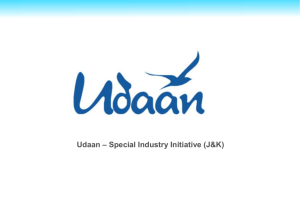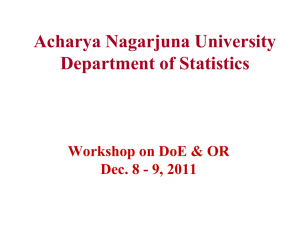PPT
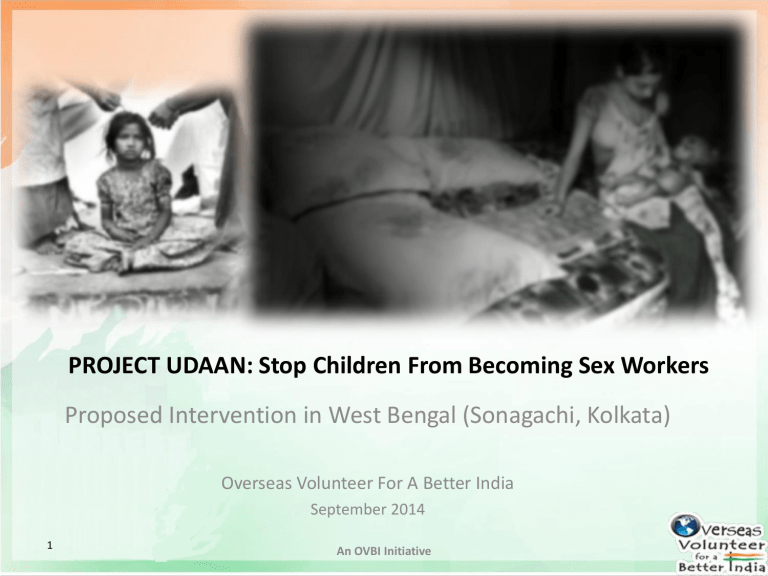
1
PROJECT UDAAN: Stop Children From Becoming Sex Workers
Proposed Intervention in West Bengal (Sonagachi, Kolkata)
Overseas Volunteer For A Better India
September 2014
An OVBI Initiative
Table of Content
•
Vision Statement
•
Introduction
•
Target Intervention & Objectives
•
Proposed Activities for the Intervention
•
Expected Impact
•
Project Budget
•
Project Plan
2
Vision Statement
Project Udaan is a path breaking effort to create Safe Havens for children of Indian sex workers and helping them to get back to mainstream of society by providing loving and compassionate care with access to healthcare, education, skills training and self growth
Current Project will support 50 children as a Pilot project in Sonagachi,
Kolkata. Plan is to implement this repeatable model and inspire other
NGO's to also take up this cause across India. Initial Estimated cost is USD
$200K.
We also plan to lobby the Indian Government to work towards the eradication of child prostitution.
3
Introduction
There are an estimated 1.2 M children of prostitutes in India
Kolkata is the major hub of trafficking activities and for forcing women and children into Commercial Sexual Exploitation (CSE)
The Problem: Barely any NGO has taken up this cause of rescuing these innocent girls because of the inherent problems that come from working in these areas. They have all the resources but don’t have the will to venture into this territory. They are looking for someone to show them the way.
The Solution: Project Udaan is a pilot project for the Sonagachi red light area in Kolkata, for creating a “Safe Haven” for 50 girls, where they can lead a normal childhood, safe from the real dangers of the flesh trade.
By setting up this “Safe Haven” we will demonstrate that such efforts can be very successful. This will encourage other NGOs to take up this cause and they will be able to reach out to the
remaining 1.2 million such needy children across India
The plan involves building a secure house away from the red light area. Our target age group is
5 – 18. We will provide them a safe home, food, clothing, modern education, health care, vocational training & most importantly HOPE
4
Target Intervention & Objectives
The objectives of the intervention are to:
1. Provide the target group with modern education facilities
2. Provide the older girls with skills training which will enable them to choose a means of earning their livelihood.
3. Create an enabling environment for children for all-round development of their personality and inculcate the passion for self- growth in their lives.
4. Inculcate good health and hygiene practices
5. De-traumatize the children through the Art of Living programs and equip them mentally, physically and emotionally for sustainable behavior transformation.
6. Create social leadership among the children for becoming leaders of social change in their community.
7. Provide counseling to children.
5
Proposed Activities for the Intervention
1. Set up a residential school for 50 girls , at a location at a distance from the Red Light areas
2. Set up Skills & Vocational Training center
3. Include service based activities in the curriculum, increase the leadership skills & self worth of the children
Include the spirituality courses in the curriculum :
Organize Bal Chetana Shibirs : Bal Chetana Shibirs have been customized especially for the all-round personality development. These Shibirs help to restore the joys of childhood, innocence, and confidence among the children.
Organize ART Excel Courses: The ART Excel course is for children aged between 8 and 13 years, it helps them gain good personal skills and nurtures their best
natural potential. ART Excel students learn life skills, yoga and breathing
processes which help eliminate fear and anxiety, techniques that enhance focus
and concentration, simple meditation and relaxation techniques, skills in
friendship, leadership and teamwork. Activities such as making a new friend each day and random acts of kindness help students to become aware of the needs of others and encourage the integration of human values into their daily lives.
6
Proposed Activities for the Intervention (cont.)
•
Empowerment programs for the Older Girl Child : Create a workforce that would undertake initiatives at the community level to identify and resolve issues, leading to improving their overall living conditions. The programs will also
nurture and groom social leadership amongst them. The participants will be provided with a wide spectrum of in-depth training with regard to their physical,
mental and emotional development for dealing with any challenging situation effortlessly and to undertake their role in the society more effectively & efficiently.
7
Expected Impact
The initiative plans at uplifting the girl child from the nightmarish, ghetto like life of the Red
Light Areas into the world which offers them opportunities equal to children from the mainstream of Society to which they are also entitled :-
1. Basic rights such as the right to live and right to protection
2. Education and opportunities to grow and develop
3. Livelihood options
4. Right against exploitation
5. Right to legal redress of grievances
The initiative also plans at developing the “Spiritual Quotient “ :
1. Developing a sense of self worth and self esteem
2. Development of a positive attitude and capacity to deal with challenging situations
3. Enthusiasm to engage with life, with friends and family in a positive sharing and caring manner
4. Improved interest in studies and play
5. Developing an attitude to live life meaningfully
8
The Project envisages the liberation from bondage of successive batches of Girl
Children from the Red Light area
Estimate for the Residential cum Vocational Training Center for 50 Girls
(A)
Capital Expenditure Land and Associated Expenses
•* Local unit for one ‘Cottaha’
•Boundary wall will be 108 running feet long and 8 feet high
Assumption: 1USD = 60 INR (Indian Rupees)
#
3
4
1
2
Item Unit
Cost of Land
Boundary walls all along the land
720 sq ft *
Landscaping
Legal and Architect Expenses
Quantity
10
108
Lump Sum
Lump Sum
Unit Rate
INR
330,000
1,410
Amount
INR
3,300,000
151,200
USD
55,000
2,520
100,000
200,000
1,667
3,333
5
Solar Power for Kitchen & Emergency area
Total (A)
(B)
Construction Cost
Lump Sum 150,000
3,869,880
2,500
65,020
# Item Unit Quantity
Unit Rate
INR INR
Amount
USD
1
The cost is estimated @Rs. 1600 per sq ft
Sq.
Ft.
4,200 1,600 6,720,000 112,000
Total (B) Construction Cost
Total (A) Land & Associated Expenses
6,720,000
3,869,880
112,000
65,020
Total Setup Cost For The Building (A + B)
(C) Working Capital
Yearly recurring expenses = $23,000
9
10,589,880 177,020
Total Funds Needed For The Project (A+B+C) $200,020
Project Plan
#
1
2
Activity
Months
Project team formation in the community
Rapport building with the community gate keepers and the stake holders and the service providers
1
Completed
Completed
Q1 Q2 Q3 Q4 Q5 Q6 Q7 Q8
2 3 4 5 6 7 8 9 10 11 12 13 14 15 16 17 18 19 10 21 22 23 24
4
Identifying & purchase of Land
5
Obtaining All
Government
Approvals
6 Construction
7
8
9
Identifying the children for the school
Inauguration & start of School
Inauguration of
Skills Training
Center
*
* *
*
*
*
*
*
*
*
*
*
*
*
*
*
*
*
*
*
*
*
*
*
*
*
*
*
*
*
*
*
*
*
*
*
*
*
*
*
*
*
*
*
*
10 Bal Chetna Shibirs * * * * * * * * *
11
12
13
10
Art Excel and
YES! Courses
Periodical monitoring and reporting
Post intervention survey and the impact study of the project
* * * * * * * * * * * * * *
*
*
*
*
*
*
*
*
*
*
*
*
*
*
*
*
*
*
*
*
BRICKS OF HOPE
DONATE A BRICK OF HOPE
TO BUILD A HOME
STOP children from becoming sex workers
One brick is for $20 donation
Visit us on Facebook: facebook.com/projectudan
11
APPENDIX
12
Annexure 1: About Overseas Volunteer For A Better India
Overseas Volunteer for a Better India (OVBI) launched in May 2013, is a 501(c)(3) organization managed by a group of inspired NRIs ready to support initiatives in India and tackle issues the Indian community faces in the U.S. Our movement’s roots are grounded in the Volunteer for a Better India
(VBI) movement. On February 3rd, 2013 more than 100,000 concerned citizens united at Ram Lila
Maidan in New Delhi in response to rampant corruption, violence towards women, suicides and water shortages. On that day, in unison the group pledged to give 1 hour a day for the nation and to inspire millions of others to do so. And Volunteer for a Better India was born.
OVBI is the overseas arm of Volunteer for Better India. We believe that every individual can make a meaningful impact and play a role in the betterment of the global Indian community. Together we can transform the world in a way that would make great leaders like Mahatma Gandhi proud. We welcome participation from all global volunteers.
13
Some Facts
Based on the study on ‘Children of Prostitutes’ conducted by Prof. K.K.
Mukherjee, Delhi School of Social Work (1991) in six major metropolitans cities including Kolkata the following can be estimated
Sonagachi has an estimated 11,000 prostitutes.
The child population in Sonagachi is estimated at 14,300
4,700 children are estimated to be illiterate.
3,400 are estimated to be in the age group 1-10 years
14
Situational Analysis
The CSWB (1990) observed that these children were vulnerable to the ways of the trade right from their childhood.
1. Often, they remain on the streets at night, when their mothers are engaged with their clients.
2. Infants, who cannot be kept out at night, sleep below the bed on which the mother has to undergo her profession.
3. Toilet and sanitary facilities are inadequate and many of the young people bathe in open places (50% of the females of 14-18 years).
4. Children feel lonely, neglected, deprived and rejected
15
Situational Analysis
1. Children are highly exposed to liquor and drug peddling, enticing clients for sex workers and eventually get involved in addiction and gang wars.
2. The girls are at high risk of getting absorbed in the flesh trade.
3. The boys end up becoming male prostitutes or pimps.
4. Sick children are mostly left unattended due to parents being busy entertaining clients.
5. The parents themselves abet trafficking, mostly for commercial gain
16
Situational Analysis
1. Shocking as it may seem, children in brothels are extremely vulnerable to trafficking and sexual exploitation.
2. A large number of children of sex workers’ are in fact trafficked into sexual exploitation (Nair, 2005).
3. Dr. P. M. Nair of UNODC (2005) considers that this group of children are mostly vulnerable because:
Most of these children are born out of ‘illegitimate’ relationship
The parents themselves abet trafficking, mostly for commercial gain
They lack care and protection
They lack education and opportunities to grow and develop
They are deprived of livelihood options
They are deprived their basic rights such as the right to live & right to protection
Right against exploitation and right to legal redressal of grievances.
17
Situational Analysis
The children of prostitutes faced a number of problems arising out of their life situation :
Social stigma, non-acceptance & social abuse
Lack of identity of fathers
Separation from the mothers indulgence/apathetic attitude of the mother
Loneliness, neglect, feeling of deprivation and rejection
Affliction with some diseases of the mother
Exposure to the world of prostitution
Lack of a father figure to provide security, care and guidance
Increased responsibility of the mother for maintenance of the children
Economic hardship
Lack of facilities to meet basic minimum needs, including health care
Unhealthy social environment
Malnutrition and ill health
18
